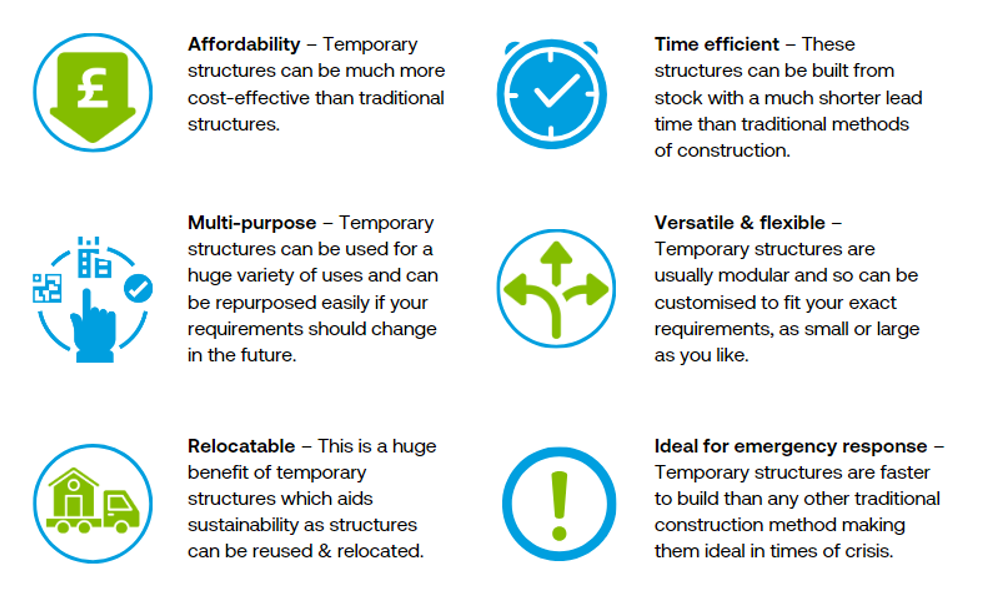5 Considerations to Make When Choosing a Semi-Permanent Structure
When planning an event, project, or temporary workspace, selecting the right structure is crucial to success. Whether it's for a corporate event, a construction site, or a seasonal retail outlet, the right temporary structure can enhance functionality and comfort while ensuring an efficient and flexible space solution.
Why are semi-permanent structures becoming a more popular choice?

Whether for an event, a construction project, or a temporary office space, choosing the right temporary structure is crucial to ensure success.
Here are five key considerations to keep in mind when selecting a temporary structure solution.
1. Purpose and functionality
The first thing you must consider is the purpose of the structure. The needs of a temporary canteen, for example, will be vastly different from those of a temporary event space.
Assess your exact requirements: Will you need large, open spaces? Will you require a complex internal fit-out? Would you like an internal mezzanine or external canopy? Do you need the structure to connect to an existing building?
Understanding the functionality will guide you in choosing the right structure which aligns with your operational needs and ensures that the space is fit for purpose.
2. Installation time and site conditions
The time it takes to install and dismantle the structure is another crucial factor. If you’re working on a tight schedule, you'll need a space that can be built quickly and taken down just as fast.
Most of our temporary structures can be erected in a matter of days, while others might take weeks depending on the complexity of the build and how much internal fit-out you will need.
The ease of installation also plays a role in the overall cost and logistical planning. You should consider the terrain and accessibility of your site, for example, if you require any groundworks to be done this will increase your cost and installation time.
3. Planning permission
You DO NOT need planning permission when:
-
The structure will be up for less than 28 days
-
The footprint of the structure has a footprint of less than 200m² (This may vary depending on your location, so it is always best to check with your local planning authority)
You DO need planning permission when:
-
The structure will be used for more than 28 days
-
If the structure is closer than 5m from the site boundaries
-
If the floor space is greater than 200m²
-
If the buildings volume is more than 25% of the existing building (if the structure is an extension of an existing venue)
-
If the structure reduces the space available for parking and manoeuvring vehicles
4. Flexibility and purchasing
You should take time to understand your purchasing options depending on how long you want to use the structure for. For example, if you need a space for 6-12 months, it can work out more cost effective to lease the structure on a monthly basis.
However, if you want a more permanent long-term solution, it may be more cost-effective to purchase the structure entirely with a one off payment.
While it might be tempting to go for the cheapest option, consider the entire cost lifecycle of the structure, including installation, maintenance, and dismantling.
Sometimes, investing more upfront can significantly reduce the overall cost of usage, especially if the solution offers energy-saving features like solar power and good insulation or is reusable for multiple events.
5. Safety and Compliance
Ensure that the structure meets all relevant safety standards and building codes. This is crucial not only for the safety ofthe users but also for legal compliance.
Our temporary structures have the following quality and safety features.
-
Fire-resistant materials
-
Secure anchoring and construction
-
NEN/BS-EN 13782 (Safety standards observed from design to installation)
-
ISO 9001 (The world’s most recognised quality management system (QMS) standard)
-
ISO 14001 (An internationally agreed standard that sets out the requirements for an environmental management system)
-
ISO 45001 (Occupational health & safety)

Conclusion
Selecting the right temporary structure solution requires a comprehensive approach, considering the intended use, site conditions, size requirements, logistical considerations, and budget constraints.
Whether for a short-term interim solution or a longer-term requirement, the right temporary structure can provide the flexibility, cost savings, and functionality you need.
